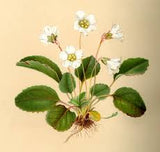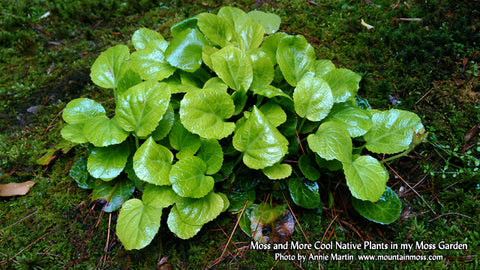Mountain Moss — #LakeJocassee
Shortia galacifolia -- Endangered Wildflower in Mossin' Annie's Moss Garden 0

The year-round green of my moss garden is punctuated with Spring blossoms of this endangered wildflower – Shortia galacifolia (Common name: Oconee Bells). While mosses are my passion, this exceptional wildflower has become a beloved favorite of mine, and so, it is the focus of this blog post. A few years ago, this moss art was my Bonsai effort with a Juniper tree. However, the little tree croaked. So, I planted some Shortia in its place. Obviously, the wildflowers are thriving in this forest driftwood. Hypnum and Hylocomium moss species have crept up the driftwood stump to create a miniature moss habitat. The flowers are so delicate and occur in early spring. The leaves last through the winter months shifting to a crimson hue. Like my mosses, Oconee Bells provide beauty at all times in the year.
Shortia has an interesting history. Most recently, actually in the 1970s, Duke Power flooded the Oconee Valley to create Lake Jocassee in upstate South Carolina, a major habitat for this rare plant. It is now considered an endangered species. My plant is a legacy plant gathered (before the flooding occurred 40+ years ago) by a native plant rescuer from Transylvania County, NC.

But the historical mystery of this plant started centuries before. Asa Gray, considered by many to be the father of American botany, was fascinated with this plant. As a professor at Harvard, his extensive collecting activities and plant classification efforts are recognized as paramount contributions to our knowledge base of plants native to the United States. Way back in 1839, Dr. Gray stumbled across an unidentified plant species collected a century before by French botanist, Andre Michaux, which were tucked away in an herbarium file cabinet.
(On a personal note: In the late 1700’s, Andre Michaux traveled extensively through the Carolinas and in the Blue Ridge Mountains that I call home. I remember learning about this explorer when I was in elementary school.)
From that loan specimen from the Jardin des Plantes in Paris, Asa Gray classified it and gave it the name Shortia after his friend, Dr. Charles Short, a botanist in Kentucky. Its second name, galacifolia, is derived from the fact that the leaves resemble Galax.
that loan specimen from the Jardin des Plantes in Paris, Asa Gray classified it and gave it the name Shortia after his friend, Dr. Charles Short, a botanist in Kentucky. Its second name, galacifolia, is derived from the fact that the leaves resemble Galax.
Back to Asa Gray’s story… after reading Michaux’s journals, he began his quest to find the elusive Shortia. Starting in 1842, for 38 years, Gray took field expeditions to the North Carolina and Tennessee mountains. He spent a lot of time looking for Shortia on Roan Mountain to no avail.The leaves are not quite as large as Galax leaves and they have more definitive veining. But, like Galax, Shortia leaves do not fall off (no dormant stage like many other vascular wildflowers). Instead, the green leaves shift to a bronze-red color that lasts throughout the winter months. Shortia is a year-round delight!
The Shortia rediscovery story continues with a 17-year-old playing a key role. In 1877, while fishing on the Catawba River in McDowell County, NC, George Hyams, noticed what turned out to be the mysterious Shortia. He took a specimen home to his Daddy who was a botanist and collector of plants of pharmaceutical purposes. The elder Hyams was astute enough to send the plant to Dr. Gray at Harvard for identification. To say the least, Asa Gray was ecstatic about this find. He responded back, “You have stumbled on what for many years I have tried so hard to find.”
 As a tribute of Gray’s love of Shortia, he requested that his final resting place be covered in these extraordinary wildflowers. The US Postal Service has produced a postage stamp honoring Asa Gray.
As a tribute of Gray’s love of Shortia, he requested that his final resting place be covered in these extraordinary wildflowers. The US Postal Service has produced a postage stamp honoring Asa Gray.
That’s not the end of the Shortia story though. The Shortia found in McDowell County is recognized as a unique variety: Shortia galacifolia v. brevistyla. It is found nowhere else in the world, folks. While the original spot where young George found Shortia has declined from over collection, there was a nearby farm with property owners who were responsible land stewards. For decades, the farm was intentionally preserved as a pristine natural setting near the location where Shortia galacifolia was rediscovered in the nineteenth century.

Good news! Through the concerted efforts of native plant lovers in North Carolina and the support of the NC Plant Conservation Program, there is now a protected area in McDowell County, NC to ensure the perpetual preservation and care of these unique plants. The Friends of Plant Conservation raised $255,000 to purchase the land and protect this historically-significant botanical site. In December 2015, this private property became a public acquisition by the N.C. Plant Conservation Program with more than a little help from their friends and contributors.
 Shortia offers delicate white/pale pink flowers in the spring and leaves that look good at any time of the year. The bronze-red hues of leaves in winter offer a great contrast to “moss” green! It is quite hardy and easy to grow. Unfortunately, Shortia is a tasty treat to deer.
Shortia offers delicate white/pale pink flowers in the spring and leaves that look good at any time of the year. The bronze-red hues of leaves in winter offer a great contrast to “moss” green! It is quite hardy and easy to grow. Unfortunately, Shortia is a tasty treat to deer.
In conclusion, Shortia galacifolia is a wonderful companion and accent plant in moss landscapes.
Note: It is illegal to gather this endangered plant from the wild. There are only a few nurseries that are certified to sell cultivated Shortia.
Published 04/10/19. Blog post written by Annie Martin. All rights reserved. Please do not copy or reproduce photos without obtaining expressed written consent from Annie Martin, www.mountainmoss.com.
